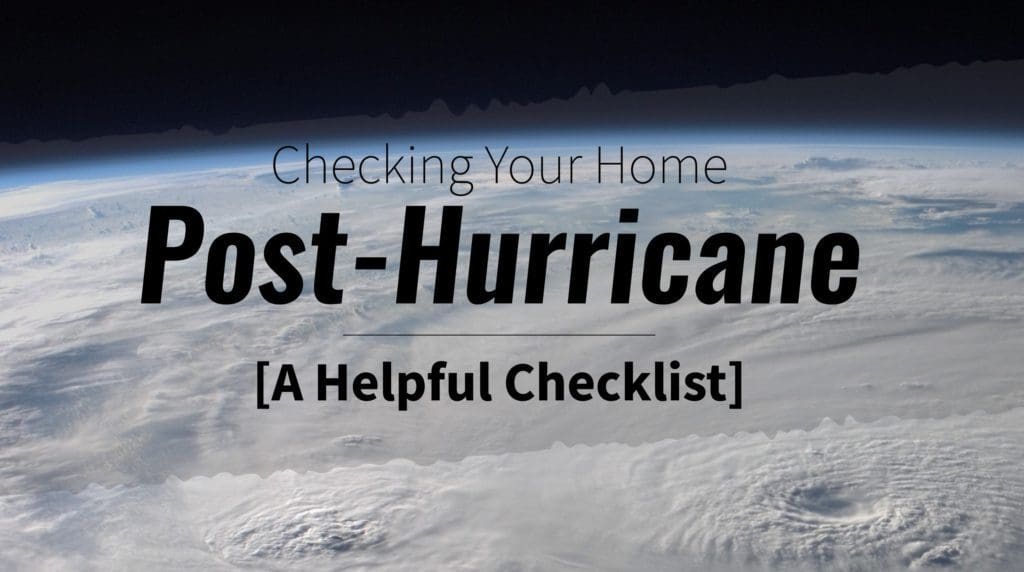Experiencing a natural disaster is incredibly scary. Sometimes, even harder than that, is all of the repairs that come afterward. Not knowing what to do in the situation can exacerbate it, but Allied Foundation has put together this handy post-hurricane checklist to help put your mind at ease and make this hard process just slightly easier.
- First thing: take pictures. Pictures help to file claims and document exactly what kind of damage may exist. Even if you may not necessarily see it, the pictures could show insurance companies what area in your house needs to be repaired. Taking pictures also helps determine if there is a change in damage over time, indicating other potential issues.
- File claims! Getting in line for government or state assistance, or insurance reimbursement is important. Everyone is going to be filing at once, so the sooner pictures can be taken and damage can be noted, the better. The higher in line you are, the quicker everything can be resolved, but remember that it will still take time. It can seem frustrating, but everything will be resolved in the end.
- For filing the claim, it’s important to take pictures of everything. Any book, piece of furniture, a patch of carpet, article of clothing, or appliance is fair game! It’s also important to document any wet walls, wet sheetrock, or wet floors. Anything that you may want to claim in the future needs to be documented.
- Inspect the roof. Check for missing shingles and document them. Think about a temporary solution that may be enough to keep the roof functional until a full repair can be done. Blue tarps are always useful. If you have a chimney, examine the stability and determine if it needs to be added to the claim.
- While on the roof, check gutters. Gutters could have been loosened by the wind but not enough that they came off. Gutters that later work themselves free could do a lot of damage to newly repaired windows or fall onto cars, or even house inhabitants or guests.
- Shutters and exterior trim are important to note. If something came loose, it may not be immediately obvious.
- Check dryer vent outlets. Wind and heavy water could easily have clogged the outlet with various debris.
- Check all electronic outlets. Any that were under the water line will need replacing, but also check the electrical service agents that may have been damaged. Any sagging or leaning indicates that they need to be replaced or worked on before risking any kind of electrical fire.
- Check your foundation. Water could easily weaken a foundation, especially in our area, due to the instability of our soil. Look at interior and exterior walls, noting any cracks. Also, keep an eye out for doors that don’t shut all the way. Don’t look just once – make it a point to keep checking the foundation repeatedly as the weeks go on. Sometimes it can take longer for foundation damage to show up. For other signs to look for, check out this list.
- If you have a fence, walk along the line of it and press against the fence in different areas, checking for any weak spots or areas that may need to be replaced.
- While looking at the fence, try and determine if any trees in the yard need to be taken down if they’ve suffered irreparable damage. Much like the gutters, if they are in a precarious spot and don’t get taken care of, they can cause a lot more damage later on.
- After claims come the clean-up. It can seem like an overwhelming process, but remember to start in one spot and do what you can – if that’s too overwhelming, try a process called June-bugging! Clean what you can in one spot, and if you get tired of it, move to another spot and clean there. There is no right or wrong way to clean up the mess. Do what’s best for you!
- When cleaning, be sure that proper ventilation is being used when it comes to cleaning with any chemicals. If you’re working with something natural, like Borax, there’s less of a risk and it works just as well, but still has proper ventilation.
- Drying and dehumidifying are key. Getting everything dry as soon as possible will ensure that mold won’t grow or spread and make things worse. Make sure that outlets being used are safe and weren’t impacted by any water damage from the storm.
- Be patient. It isn’t easy, and the flood of claims that come in after a storm can mean long wait times. Keep receipts for any repairs that are done on your own that were too dire to wait to have done, and ensure that everything is documented along the way. It will help keep the process running smoothly with the insurance company and ensure that everything will be accounted for in the final estimates.
Cleaning and repairing after a storm can, and almost always will be, a process. It will be time-consuming and at times and it may be very difficult, but it is important to note that there is a light at the end of the tunnel. For any foundation concerns, Allied offers free foundation estimates. Give yourself peace of mind by ensuring that your home is safe even after the storm.

